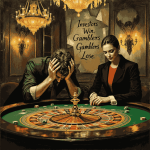
Classical Conditioning vs Operant Conditioning in Investing: Master Market Psychology
July 31, 2024
In the ruthless investing arena, where fortunes are made and lost in the blink of an eye, the masses often behave like programmed automatons, their actions driven by deep-seated psychological conditioning that compels them to act against their interests. This essay will plunge into the fascinating world of “Classical Conditioning vs Operant Conditioning in Investing” and often disturbing depths of investor psychology, revealing how market participants respond to financial stimuli with the predictability of Pavlov’s dogs – often with devastating consequences.
We stand at the crossroads of two powerful psychological forces: Classical Conditioning and Operant Conditioning. These twin titans of behavioural science shape the landscape of financial markets, creating patterns of behaviour as predictable as they are irrational. From the opening bell of Wall Street to the late-night tweets of tech billionaires, we’ll explore how these conditioning mechanisms mould the minds of millions, driving market booms and busts with the precision of a Swiss watch.
But this is not merely an academic exercise. As we peel back the layers of market psychology, we’ll give you the knowledge to break free from these mental shackles. You’ll learn to recognize the subtle cues that trigger mass behaviour, resist the siren song of herd mentality, and exploit the predictable irrationality of others for your gain.
Prepare to embark on a journey through the twisted corridors of the investor’s mind. By the end, you’ll understand not just how markets move but why they move – and how you can position yourself to profit from the psychological pitfalls that ensnare the unsuspecting masses. The bell is about to ring. Are you ready to master market psychology?
The Bell Rings and the Dogs Salivate
Imagine a bell ringing, signalling the opening of the stock market. Like conditioned dogs, investors start drooling at the prospect of gains, driven by an almost instinctual response to market movements. This is a classic example of Classical Conditioning, a phenomenon first discovered by Ivan Pavlov. In his famous experiment, Pavlov conditioned dogs to associate the sound of a bell with food, leading them to salivate at the mere sound, even without food.
Similarly, investors are conditioned to respond to market cues and stimuli without rational thought. For instance, the mere mention of a Fed rate hike sends markets into a frenzy, with investors rushing to sell stocks, even if their fundamental analysis suggests otherwise. This is a prime example of Classical Conditioning in action, where investors have been conditioned to associate certain stimuli (rate hikes) with specific outcomes (stock market crash).
Market Rewards and Punishments
Operant Conditioning, a theory proposed by B.F. Skinner also plays a significant role in investor behaviour. This theory suggests that rewards and punishments influence behaviour. In the context of investing, market participants constantly seek rewards (profits) and avoid punishments (losses). However, the market often presents a distorted view of these concepts, leading to irrational behaviour.
For instance, the fear of missing out (FOMO) is a powerful driver of investor behaviour. When a particular stock or asset class surges, investors rush to buy, driven by the fear of being left out of potential gains. This is a classic case of positive reinforcement, where investors are rewarded with profits, encouraging them to repeat the behaviour. However, this can also lead to herd mentality, where investors blindly follow the crowd, often buying at market tops.
On the other hand, the pain of losing money is a mighty punishment that can lead to irrational decision-making. Investors often fall prey to the disposition effect, tending to sell winning stocks too soon to lock in gains while holding onto losing positions, hoping for a rebound. This is a form of negative reinforcement in which investors seek to avoid the pain of losses, even if it means missing out on potential gains.
The Impact of Cognitive Biases on Technical Analysis:
While widely used, technical analysis is susceptible to cognitive biases that can lead to flawed interpretations and poor investment decisions. Here are some fundamental biases and their impacts:
– Confirmation Bias: Traders often seek patterns that confirm their beliefs. For example, a bullish trader might interpret a “golden cross” (when a short-term moving average crosses above a long-term moving average) as a strong buy signal while ignoring other bearish indicators.
– Anchoring Bias: Investors may fixate on specific price levels or indicators. For instance, traders might cling to the idea that a stock “always bounces” at a certain support level, even when market conditions have changed.
Recency Bias leads traders to overemphasize recent price movements. During the 2020 COVID-19 market crash, many technical analysts failed to anticipate the rapid V-shaped recovery, as they were anchored to the recent downtrend.
– Gambler’s Fallacy: Some traders believe that if a stock has gone up several days, it’s “due” for a pullback, even though each day’s price movement is independent.
Example: In 2018, many Bitcoin technical analysts predicted continued upward momentum based on historical patterns, even as fundamental factors shifted. This led to significant losses for those who failed to recognize the changing market dynamics.
To combat these biases, traders should:
1. Use multiple timeframes and indicators
2. Regularly challenge their assumptions
3. Incorporate fundamental analysis alongside technical analysis
4. Maintain a trading journal to track decision-making processes
Social Media & Classical Conditioning vs Operant Conditioning
Social media has revolutionized how information spreads in financial markets, often amplifying psychological biases and herd behaviour:
– Echo Chambers: Platforms like Twitter and Reddit can create echo chambers where investors reinforce each other’s beliefs. The GameStop (GME) short squeeze in 2021 is a prime example, where Reddit users on r/WallStreetBets coordinated to drive up the stock price, defying traditional valuation metrics.
– Influencer Impact: High-profile investors and celebrities can move markets with a single tweet. For instance, Elon Musk’s tweets about Dogecoin led to significant price swings in the cryptocurrency throughout 2021.
– Rapid Sentiment Shifts: Social media accelerates the spread of information and misinformation, leading to rapid shifts in market sentiment. The 2013 Associated Press Twitter hack falsely claimed the White House had been attacked, causing a brief but sharp drop in the S&P 500.
– FOMO Amplification: Social media can intensify the fear of missing out. During the 2020-2021 bull run, many retail investors piled into “meme stocks” and cryptocurrencies after seeing others post about their gains online.
Data point: A 2019 study by the University of Oxford found that 97% of retail investors use social media for investment information, with 41% saying it “significantly influences” their investment decisions.
To navigate this landscape:
1. Diversify information sources
2. Verify information before acting
3. Be aware of your emotional responses to social media content
4. Use social sentiment analysis tools cautiously as part of a broader strategy
Breaking the Chains of Conditioning
So, how can investors break free from psychological conditioning and exploit market psychology? It requires a conscious effort to recognize and understand these biases and then develop strategies to counter them.
One approach is to focus on long-term investing, ignoring the short-term noise that often triggers conditioned responses. By adopting a buy-and-hold strategy, investors can avoid the constant stimuli of market fluctuations and the associated behavioural traps. Another approach is to utilize dollar-cost averaging, where investors buy a fixed amount of an asset at regular intervals, smoothing out the impact of market volatility.
Mass Psychology, contrarian investing, and critical thinking are powerful tools. By understanding the underlying principles of investing and market dynamics, investors can make more informed decisions, reducing the influence of emotional responses. Recognizing behavioural biases and implementing strategies to counter them, such as setting clear investment criteria and sticking to them, can help investors make more rational choices.
Conclusion: Classical Conditioning vs Operant Conditioning
Investors, like Pavlov’s dogs, are often conditioned to respond to market stimuli in predictable ways. However, investors can break free from these mental chains by understanding the principles of Classical and Operant Conditioning. Investing is as much a battle against one’s psychology as against market forces. By recognizing and countering these behavioural biases, investors can turn market psychology to their advantage, making more rational and profitable decisions.
The bell may ring, but investors must choose how they respond. Will they salivate like conditioned dogs or break free from psychological conditioning and master the market’s psychology? The choice is theirs, and the rewards are significant for those who can control their instincts and think independently.
The Art of Discovery: Articles that Open New Worlds















